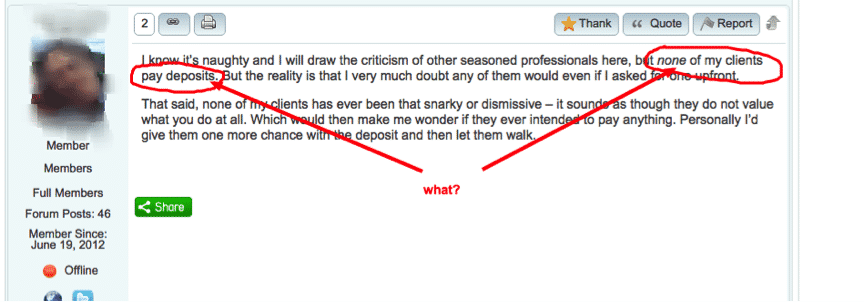So, I’m going to spoil this article for you right away, usually I’ll try to save the gold nuggets for later in the post but this information is just too important to keep you waiting.
The ONLY way you can ensure getting paid on time is by being ruthless about it, and setting firm payment terms and guidelines.
Don’t get me wrong, I’m not saying you should start sending late paying clients threatening letters or engage in any other hostile activities, no.
By ruthless I mean becoming firmer with the way you handle clients and payments.
Here are a few tips for making it happen.
1. Be firm with your payment terms
Let’s drop the altruism plaguing many freelancers’ websites and biographies:
You’re not managing a client’s marketing campaign, improving their organic rankings or increasing conversions for the sheer satisfaction of seeing them succeed.
That’s the outcome you aim for, true. But in reality, you sell your knowledge, experience and time to build and enjoy the lifestyle you want. And freelancing can be a pretty sweet gig indeed.
The freelance lifestyle is great, but it’s hard to achieve unless you get paid for your work. And the best way to avoid the slings and arrows of the freelance industry is to set firm payment terms and communicate them to your clients.
Your payment terms should clearly state:
When you need to get paid
You should set a defined payment schedule (more on this later) so that clients know exactly when and how you need to get paid.
How much
Your terms should include information about the deposit amount and a breakdown of your fees.
Late payment penalties
I have always wondered why most freelancers are afraid to charge fees for late payments. Your bank and phone company don’t have a problem with it. Why shouldn’t it apply to your business?
What most people don’t consider is it’s very expensive to offer credit. It can devastate your cash flow, force you to seek high-interest financing, and push you to take on low-end projects just to make ends meet.
Not cool.
What’s more interesting is that the knowledge alone, that fees will be applied to overdue accounts, often compels clients to pay your invoices on time.
In short, ensure your terms include a list of penalties you’re going to include for any payment delays.
2. Collect deposits every time
I’m always amazed by how many freelancers, beginners and seasoned professionals alike, fail to collect deposits before starting the work.
This can be a recipe for disaster.
Here are two screenshots from a discussion on this topic on a forum I frequent. You can easily find plenty of similar examples all over the web.


What also amazes me is how fierce the debate regarding collecting deposits is.
My stance on the topics is simple:
If you want to guaranty payment, never start a project without first collecting a deposit.
Here’s why…
Deposits confirm commitment
Without investing money in a project, clients can change or abort any project at any time. After all, what have they got to lose?
A deposit, confirms that the client, at a minimum, wants to launch the project.
It also signals that they are able to pay
Being able to pay the deposit is an indication that they have the money for the entire project. You can’t be 100% certain but with a deposit, the client usually has the finaces to pay the rest.
Deposits can keep you afloat
Imagine working on a 2-month project without a deposit. That’s just craziness. Unless you have plenty of money tucked under the mattress, half way through the project you might find yourself unable to cover your expenses.
A deposit provides a float of money to get you through to the project’s completion.
It makes you look more professional
To me, not asking for a deposit immediately screams lack of professionalism and confidence.
Doing the opposite, however, tells clients that you’re a pro. After all, no established business blindly starts a project without collecting a deposit. Neither should you.
How much of a deposit should you collect?
To be honest, there is no one-size-fits-all solution.
Some freelancers require 50% upfront, with the rest payable on delivery. Others work by 33/33/33 rule, charging a 3rd (or other percentage) for each stage of the project.
Some freelancers set deposit thresholds. My friend and fellow freelancer Pawel Grabowski, for instance, requires a payment upfront for any project below €1000 and 50% upfront (with the rest payable on the delivery of the first draft) for anything above that.
For my services, I require a minimum of 50% deposit, and in some cases 100% of the project fee before I get started. Best part is, I rarely get pushback from clients.
3. Bill in chunks
When I started out my invoicing was fragmented and inconsistent. I’d have a mix of web design, and digital marketing projects. All of which had different payment terms and start dates.
It made sense to me then. However, I learned that standardizing my payment terms and automating the process were the paths to success.
It also taught me another important lesson.
Net 30 is for suckers
Most freelancers will default to net 30 payment terms. It seems logical, right? And, everyone’s doing it.
But, if you’ve already committed to providing a month of services (without payment) then have net 30 terms, it could take up to two months to get paid. And that’s providing the clients aren’t late with payments.
To avoid this, bill frequently, ideally in chunks.
If you’re working on net 30 terms (which means that you allow your client 30 days to pay your invoice) you should issues invoices frequently, weekly or biweekly, to reduce the gap between the invoice and getting paid.
It’s still less than ideal as it forces you to wait 30 days for the payment anyway but it’s better than delaying and billing all of your monthly activities at one time.
The other solution is to require payment on receipt.
In this case, the client is expected to pay you the moment the invoice is delivered. Many web designers and creatives invoice by this rule to great effect.
A word about contracts and their role in collecting payments
Many freelancers consider contracts the ultimate form of protection from client abuse. To me, however, contracts just don’t cut it.
For small projects, say under $1,000. The amount of time, money, and energy needed to take someone to court is a wasted exercise. Contracts are nothing more than a form of commitment and a way to state your terms, conditions and ownership of the final product. But they do not ensure payment – not by a long shot.
They provide reassurance that you will get paid at some point in the future. But, if you’re forced to take a client to court, that time in the future might be months, if not years before you receive a ruling.
Ultimately, you’d benefit more from including firm terms and conditions on your invoice and setting up structured invoicing processes than forcing a client to sign a contract.
4. Automation is your best friend
Let’s be honest here, admin tasks like billing and chasing payments can take a butt load of your time. Not to mention, they eat into your revenue.
Luckily, you can automate a lot of those processes and even ensure you get paid on time, too.
For instance, Freshbooks and Stripe, when integrated, allow you to collect a credit card, which is automatically processed at scheduled intervals. Freshbooks can send pre-scheduled invoices and charge the person’s credit card.
No more creating invoices manually, processing payments and all that other jazz.
Yes, there is a 3% fee, but who really cares? It’s small potatoes. I’d much rather lose 3% per transaction, than risk receiving no payment at all.
And when payments are overdue, Freshbooks can also send payment notifications to late payers. This is a great way to communicate the late payment penalties, etc.
My notices increase in severity from:
- Please make a payment (15 days late payment)
- Your account is overdue (20 days late)
- We are discontinuing services, unless… (30 days late)
When I make concessions
Yes, I admit, on occasion I do make concessions. Just like with anything else in life, there are unique situations that require some flexibility.
But I only do it because I have a steady recurring income from other contracts.
Why, because it’s easy to sign up a client based on flimsy payment terms. But it’s likely you’ll find yourself waiting for a payment 4 months down the line without any indication of when it might happen, if at all.
There are other situations when you might have to make concessions.
Some businesses, regardless of what you request in your terms, will not hire you unless you bend to their will. This isn’t to say you should necessarily work with these businesses, however, this is a brick wall you will come up against.
In those situations, only accept payment terms when you have a guarantee of direct deposit payments on a specified date. And, still collect the deposit. Full stop.
So to reiterate…
Want to get paid on time? Be ruthless about it.
Set strict terms, be firm about them, collect deposits and bill often.
And never bend your rules unless you have a steady flow of recurring income already coming in.

